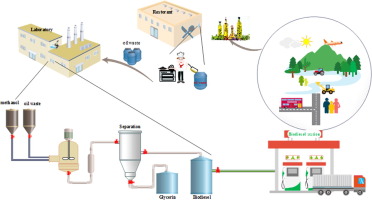Waste Management ( IF 7.1 ) Pub Date : 2020-02-28 , DOI: 10.1016/j.wasman.2020.02.032 Rauf Foroutan 1 , Reza Mohammadi 2 , Hossein Esmaeili 3 , Fatemeh Mirzaee Bektashi 2 , Sajad Tamjidi 4

|
In the present research, application of waste edible oil (WEO) as a suitable and abundant source for biodiesel production using CaO@MgO nanocatalyst derived from waste chicken eggshells was studied. To this end, FT-IR, XRD, SEM, EDX, Map, and TEM analyses were performed to investigate characteristics of the CaO@MgO nanocatalyst. Also, the physical properties of the biodiesel such as flash point, kinematic viscosity, density, distillation point, cloud point, pour point, cetane number, oxidation stability, and acid number were determined according to the international standards. In addition, FT-IR and HNMR analyses were used to determine the biodiesel characteristics. Moreover, the produced catalyst was successively reused for up to 6 cycles and the results showed that the catalytic activity of the catalyst produced was sufficient for biodiesel production from WEO for up to three cycles, beyond which its catalytic activity decreased. The present work further considered the effects of different parameters on biodiesel production using central composite design to determine optimal conditions. According to the results, the highest biodiesel conversion yield (98.37%) was achieved in a reaction time of 7.08 h, reaction temperature of 69.37 °C, methanol-to-oil ratio of 16.7:1, and catalyst concentration of 4.571 wt% which shows the highest biodiesel conversion yield ever achieved from waste edible oil.
中文翻译:

使用氧化钙@氧化镁纳米催化剂将废食用油转化为生物柴油。
在本研究中,研究了将废食用油(WEO)用作利用废鸡卵壳衍生的CaO @ MgO纳米催化剂生产生物柴油的合适来源。为此,进行了FT-IR,XRD,SEM,EDX,Map和TEM分析,以研究CaO @ MgO纳米催化剂的特性。此外,根据国际标准确定生物柴油的物理性质,例如闪点,运动粘度,密度,蒸馏点,浊点,倾点,十六烷值,氧化稳定性和酸值。此外,FT-IR和HNMR分析用于确定生物柴油的特性。此外,所生产的催化剂连续重复使用多达6个循环,结果表明,所生产的催化剂的催化活性足以满足WEO生产生物柴油的多达3个循环,超过此循环其催化活性就会降低。本工作进一步考虑了使用中央复合材料设计确定最佳条件的不同参数对生物柴油生产的影响。根据结果,在7.08小时的反应时间,69.37°C的反应温度,16.7:1的甲醇/油比和4.571 wt%的催化剂浓度下,可获得最高的生物柴油转化率(98.37%)。显示出从食用废油中获得的最高的生物柴油转化率。本工作进一步考虑了使用中央复合材料设计确定最佳条件的不同参数对生物柴油生产的影响。根据结果,在7.08小时的反应时间,69.37°C的反应温度,16.7:1的甲醇/油比和4.571 wt%的催化剂浓度下,可获得最高的生物柴油转化率(98.37%)。显示出从食用废油中获得的最高的生物柴油转化率。本工作进一步考虑了使用中央复合材料设计确定最佳条件的不同参数对生物柴油生产的影响。根据结果,在7.08小时的反应时间,69.37°C的反应温度,16.7:1的甲醇/油比和4.571 wt%的催化剂浓度下,可获得最高的生物柴油转化率(98.37%)。显示出从食用废油中获得的最高的生物柴油转化率。











































 京公网安备 11010802027423号
京公网安备 11010802027423号